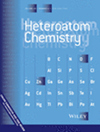Heteroatom Chemistry is designed to bring together a broad interdisciplinary group of chemists who work with compounds containing main-group elements of groups 13 through 17 of the Periodic Table and certain other related elements. The fundamental reactivity should in all cases be concentrated about the heteroatoms. It does not matter whether the compounds being studied are acyclic or cyclic; saturated or unsaturated; of a monomeric polymeric or solid state nature; inorganic organic or naturally occurring so long as the heteroatom is playing an essential role. Also both experimental articles and those based on computational chemistry are welcomed. In general Heteratom Chemistry will not accept manuscripts based on classical heterocyclic chemistry (for which several special journals are available). It welcomes however interesting articles on heterocyclic systems beyond the scope of classical organic chemistry. On a more positive note there are many areas of research that are unmistakable examples of heteroatom chemistry. These include structures and reactions that exhibit (a) unusual valency of highly coordinated main-group element compounds; (b) characteristics and unusual properties of low coordinate main-group element compounds; (c) characteristics and unusual properties of highly strained main-group element compounds; (d) similarities between main-group compounds and transition metal compounds; (e) facile photochemical or thermal cleavage of bonds involving heteroatoms that lead to highly reactive intermediate species; (f) the unusual reactivity of compounds that contain multiply bonded heteroatoms; (g) the unusual structures and reactivities of highly catenated heteroatoms; (h) specific and unusual neighboring group effects of heteroatoms on physical and chemical properties of compounds; (i) useful influences on synthetic processes; and (j) wide applicability over many elements of the Periodic Table e.g. ligand coupling within hypervalent species; variations on the immensely important Wittig reactions; and the stereochemistry of compounds based on the influence of heteroatoms present in the molecules. These statements are not designed to limit the scope of heteroatom chemistry; rather they are intended to illustrate the many ways in which heteroatoms play essential roles in the chemistry of compounds containing them.
